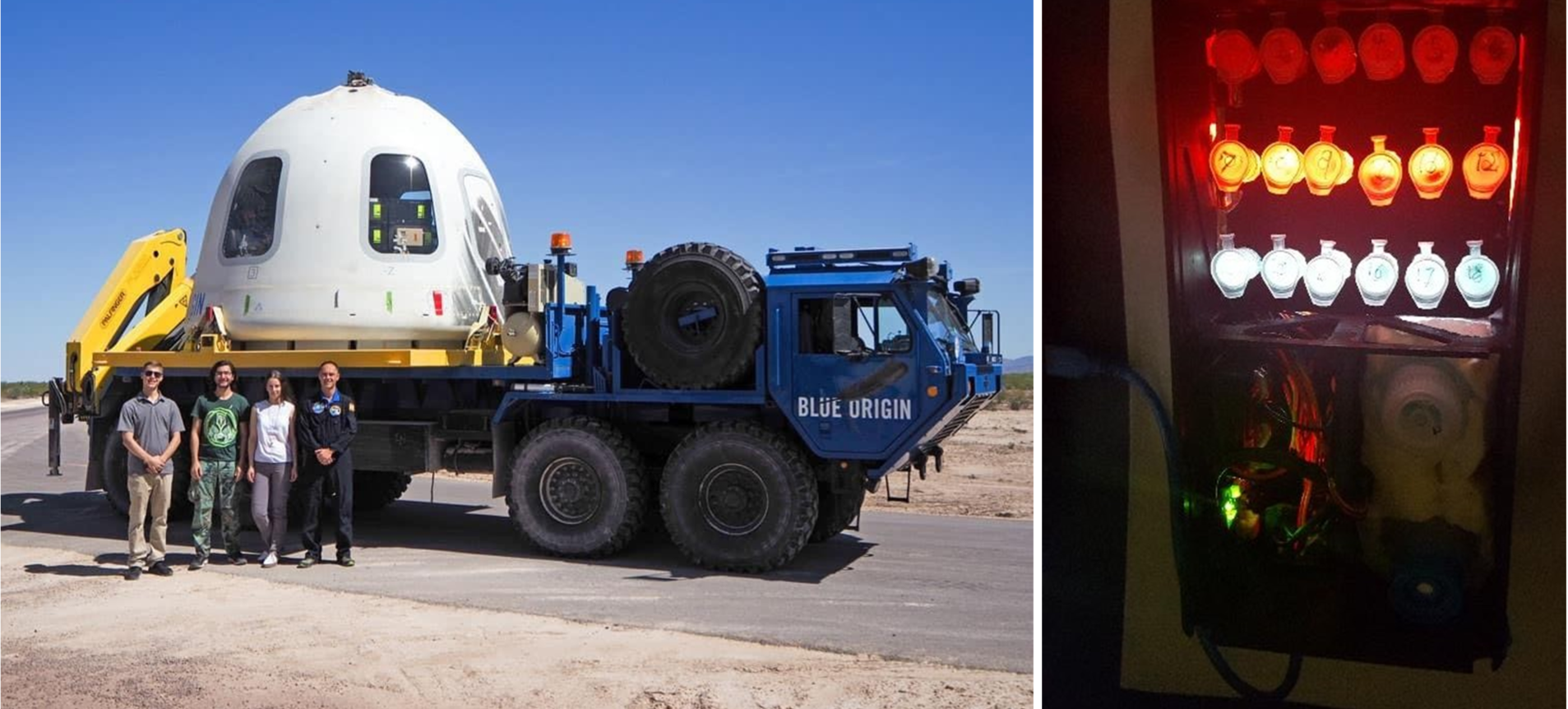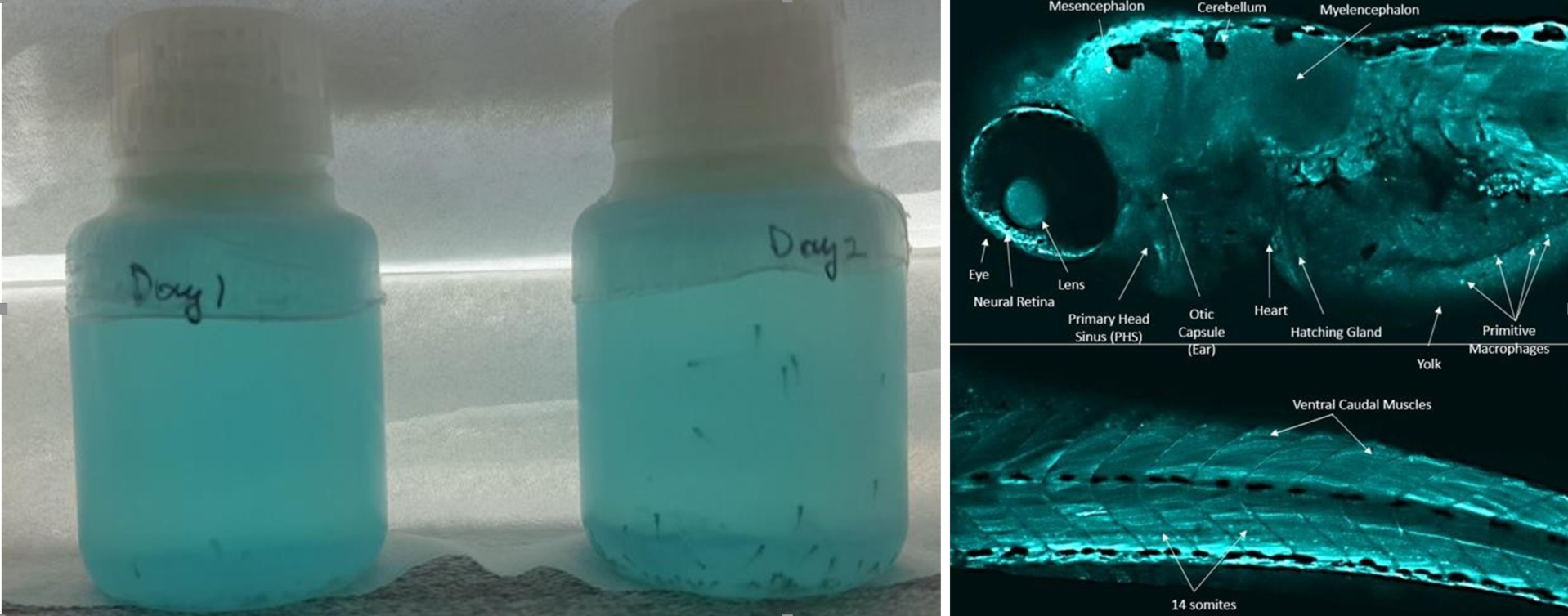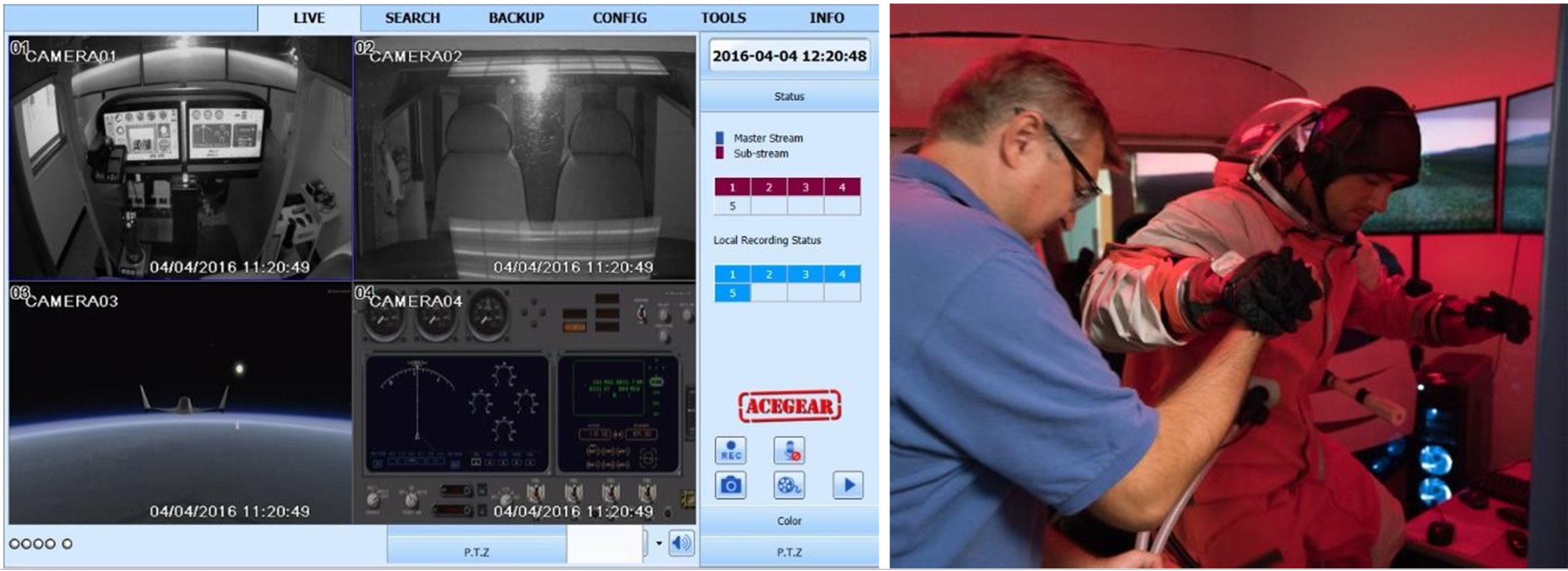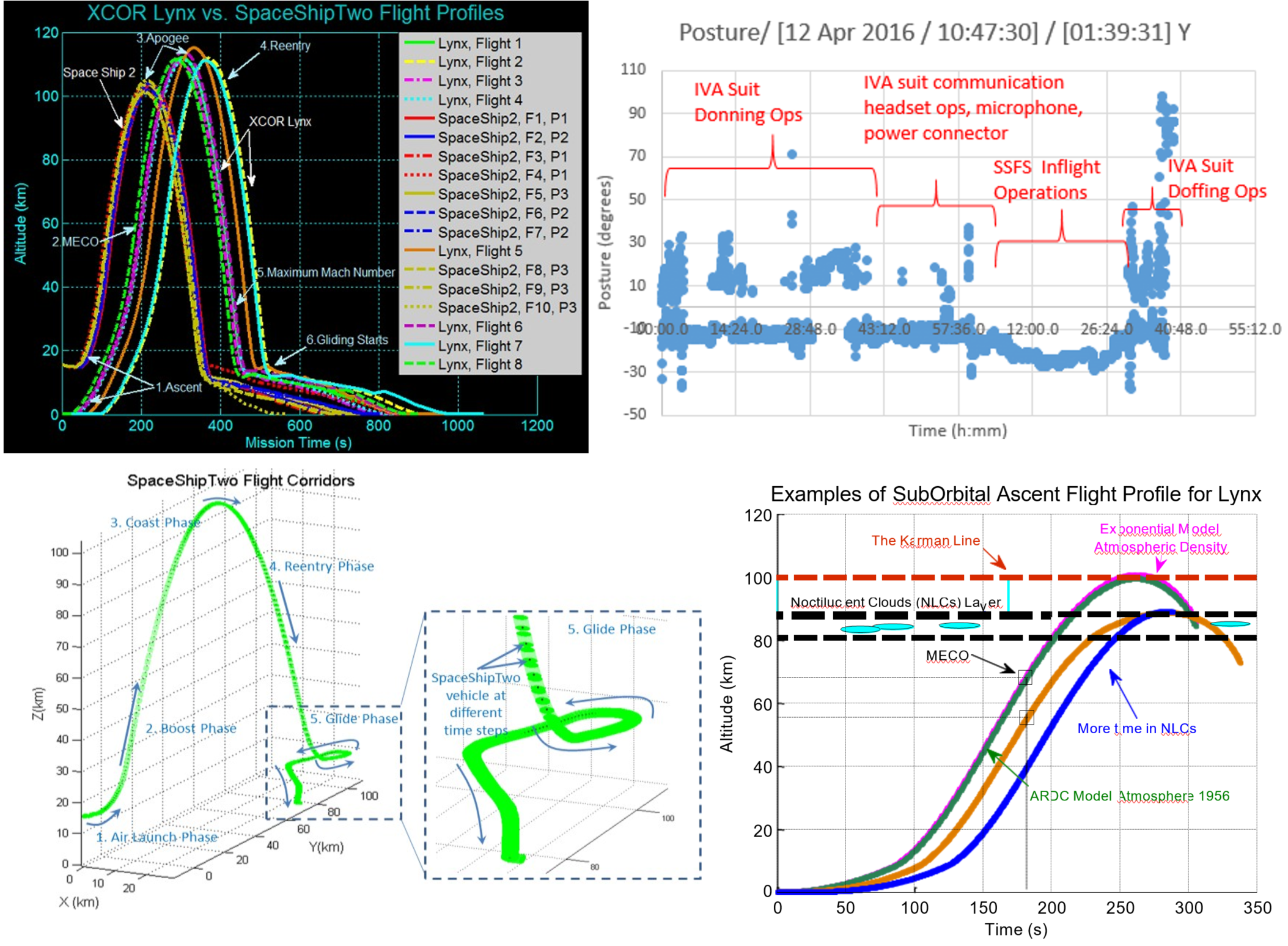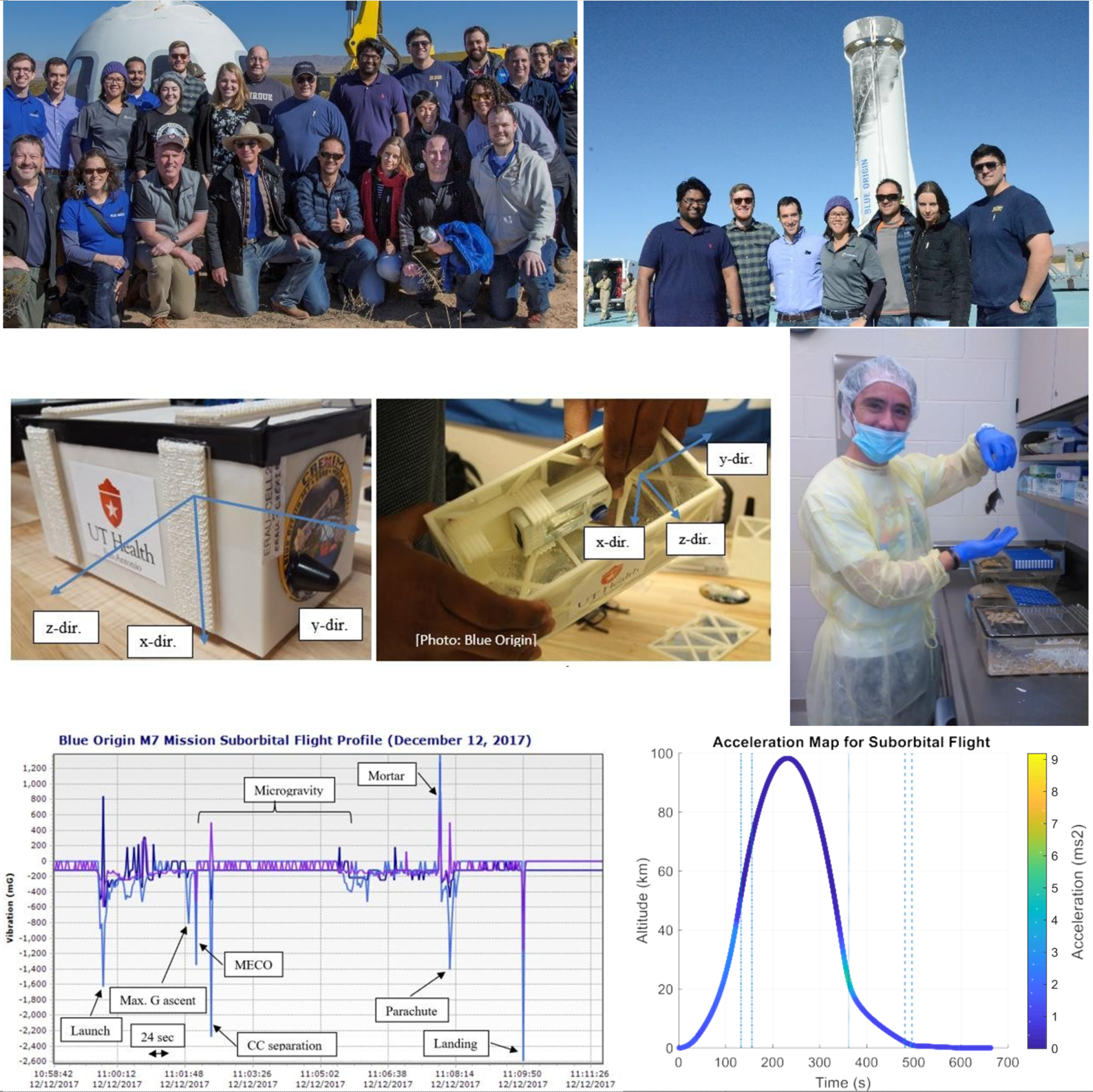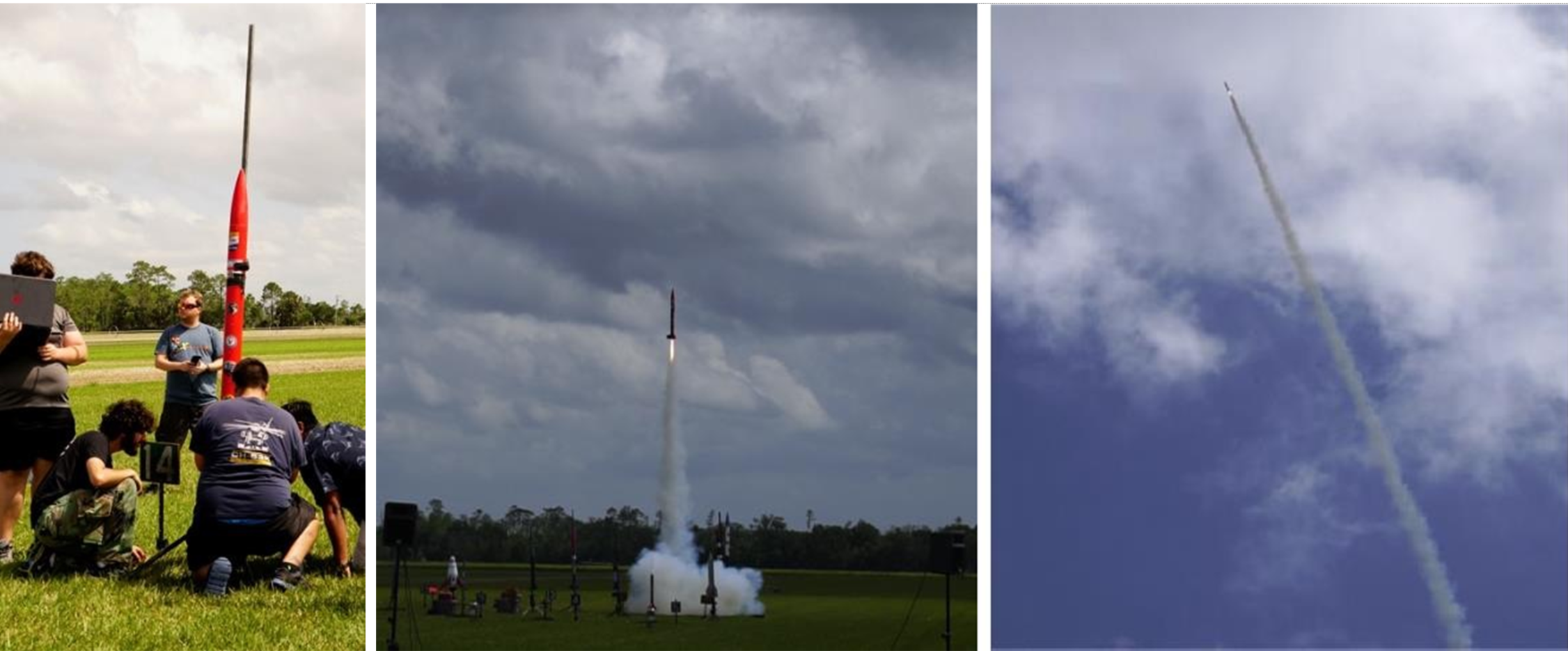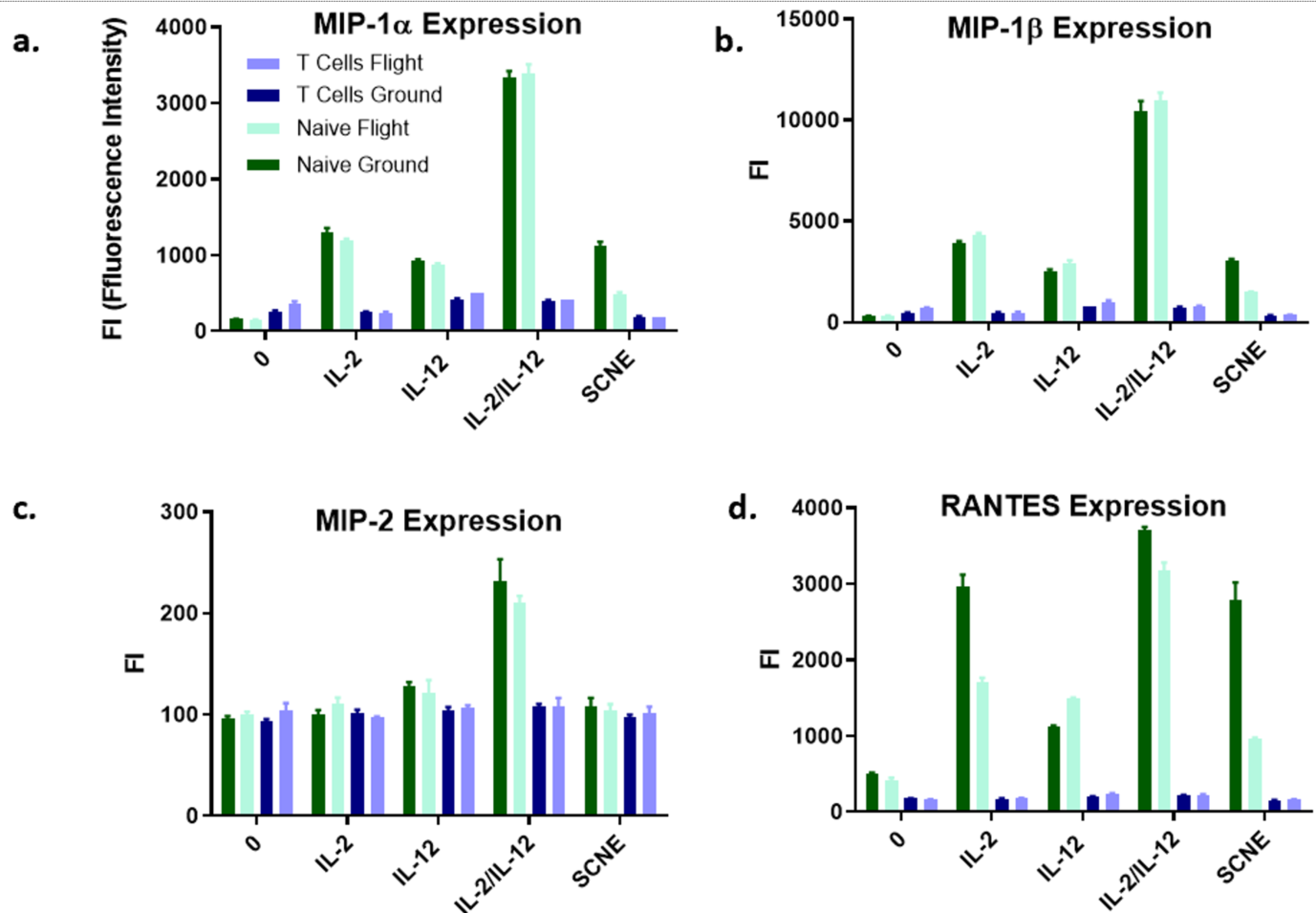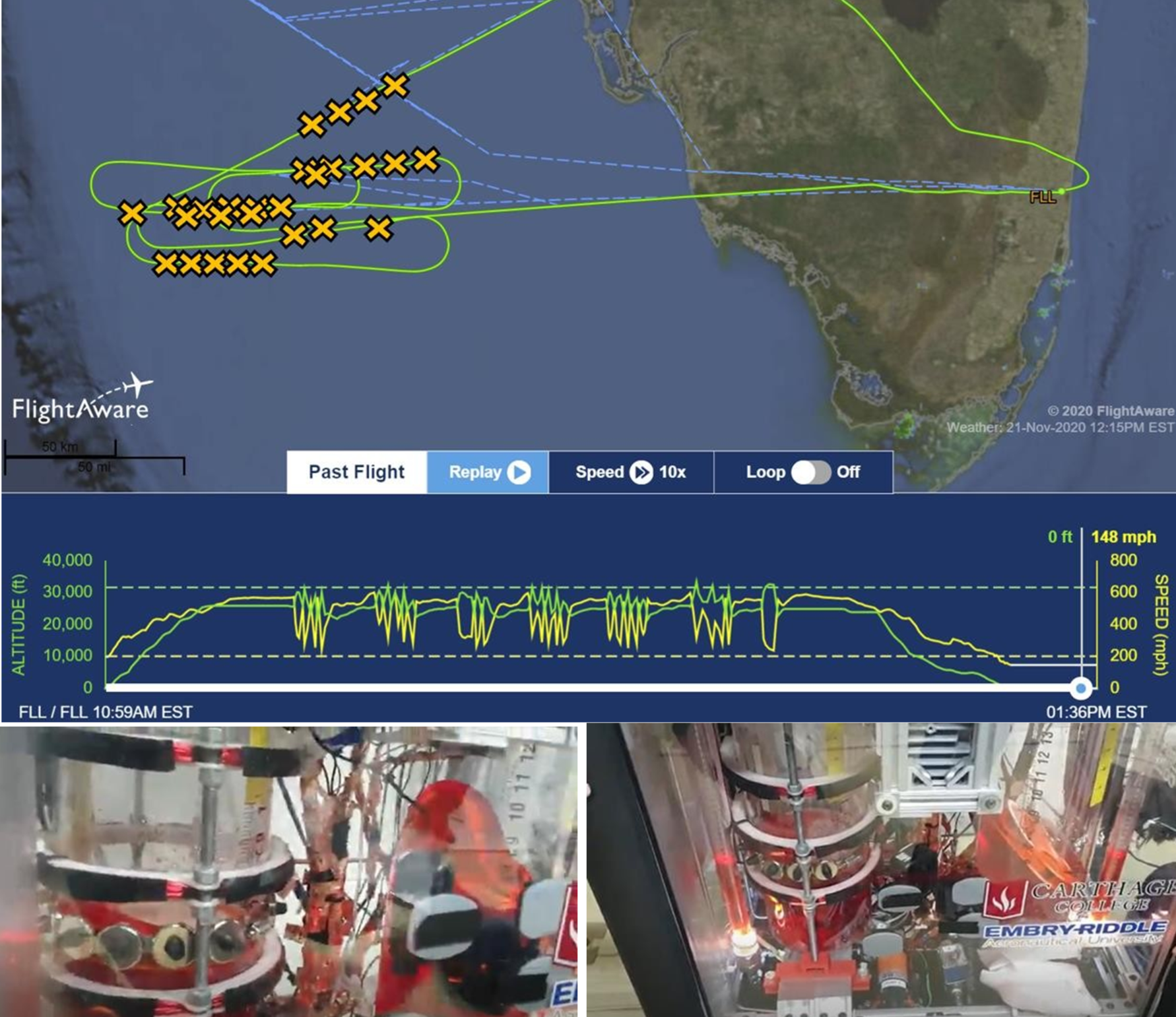11-20 of 21 results
-
Blue Origin’s Suborbital Research: MESSI/McXIMUS
PI Pedro LLanos
CO-I Sathya Gangadharan
The following studies were conducted with Co-PIs Dr. Sathya Gangadharan (ERAU) and Kristina Andrijauskaite (University of Texas Health Science Center in San Antonio [UTHSCSA]).
MESSI Summary: This project was ERAU's second suborbital payload aboard Blue Origin’s New Shepard launched May 2, 2019. We analyzed the effects of suborbital flight stressors and various light conditions (red, white, no light) on the Arthrospira platensis, commonly known as Spirulina, aboard Blue Origin’s New Shepard launch vehicle. Commercially available cyanobacterium species were cultivated and closely monitored in mother colonies several months before the flight. The aim was to estimate biomass production and growth as a potential dietary alternative for prospective human spaceflight's life support system.
McXIMUS Summary: Zebrafish larvae were exposed to the same physiological stressors they would encounter during suborbital space flight: alterations in light, thermal, and centrifugation conditions, and their behavioral responses were analyzed using the DanioVision (Noldus) behavioral tracking system. Our results showed that zebrafish were most active when kept in a dark environment as measured by swim distance. Also, thermal alterations revealed that zebrafish larvae adapted well to the different temperatures ranging from 25°C to 32°C with the highest levels of locomotor activity observed at 32°C. Finally, the centrifugation tests demonstrated that although zebrafish were exhausted initially, their recovery process was short, lasting for approximately five minutes.
Spirulina Research: The Microgravity Experiment for Spirulina as Superfood In-Vitro (MESSI) was funded by internal funds from ERAU and UTHSCA and ERAU's 2018-2019 Ignite Research Grant. Spirulina samples were flown in a NanoLab with adjacent avionics supporting the light conditions and sensors to monitor the temperature, relative humidity, and accelerations. The various flight parameters measured in the NanoLab were validated with the flight data gathered by Nanoracks. Preliminary results of the genes affected by the temperature and light alterations are presented. Our data indicate that the spirulina samples aboard the rocket had elevated expression of most genes when compared to ground controls, especially genes related to magnesium (mgtE) and nitrate-nitrite (nrtP) transport. Furthermore, we saw the most significant up-regulation (p < 0.01-0.001) of genes from the blue-green spirulina microalgae exposed to the red light. Finally, we used laser-scanning confocal microscopy to provide high-resolution imaging visualizations of the spirulina under different conditions (ground, flight, and light conditions). Results indicate that flight samples exposed to red light had the most profound effect on gene expression and showed an enhanced behavior suggesting that photosynthetic organisms are influenced by light energy. Although it is well-known that spirulina needs light and warmth to optimally grow, our findings indicate that spirulina may be able to survive and grow with no light and at lower temperatures than optimally cultivated conditions, which may reduce hardware and resources dependency for prospective long-duration human spaceflight.
Zebrafish Research: Microgravity characterization eXperiment In Microgravity Universal Spacelab (McXIMUS). It has been proved that the presence of humans in space requires meticulous mission design and a critical understanding of physiological parameters. Space is a hostile environment that has caused numerous health hazards in astronauts, including alterations in the vascularization system and high rates of muscle atrophy. Therefore, understanding the molecular pathways mediating space-induced alterations on human physiology is a necessity in making future missions a success. The goal of this study was to use zebrafish (Danio rerio) embryos as a unique model to study molecular mechanisms of simulated and real microgravity effects on vascularization system and stress response. To simulate microgravity, we exposed zebrafish embryos to a two-dimensional clinorotation device starting 1-day postembryonic fertilization (dpf) and lasting for a maximum of four days. Changes in multiple gene expression were measured by qRT-PCR. Thus, we used the KDRL- BSY zebrafish strain with the blue fluorescently labeled vascular system allowing to image vascularization development using confocal microscopy. Our preliminary results indicate that only a small proportion of genes are affected by clinorotation. Our next goal was to confirm our findings by exposing zebrafish embryos (days 2 and 3 dpf) to microgravity during the suborbital flight aboard Blue Origin’s New Sheppard vehicle in the spring of 2019. Our project entitled Muscular characterization in Microgravity Universal Spacelab (McXIMUS) is a joint research collaboration between the Embry- Riddle Aeronautical University (ERAU) and the University of Texas Health Science Center in San Antonio (UTHSCSA). To ensure a safe environment for zebrafish embryos during the suborbital flight, we designed a NanoLab to guarantee stable thermal conditions inside the payload. Our team has established proper procedures and validation checks to maximize the outcome of this novel scientific experiment. Our data indicate that in contrast to clinorotation, zebrafish embryos exposed to suborbital flight had the up-regulated expression of multiple gene families, with the most profound effect observed in vascular endothelial growth factors and heat shock proteins. To the best of our knowledge, this is the first time when Danio rerio was flown on the suborbital flight mission to assess microgravity-induced alterations on the vascularization system and stress. Here, we present only the preliminary results of our ongoing gene expression analysis, as we are further elucidating the possible mechanisms of action. Findings from this experiment give insights into molecular pathways mediating vascular system and stress response and will assist in mapping out the strategies aimed to minimize the antagonizing effect of space travel in humans.
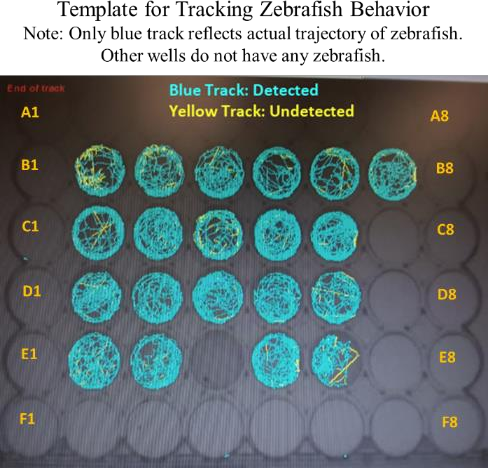
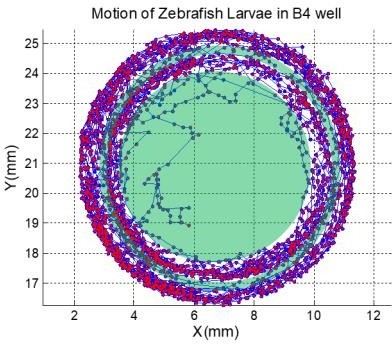
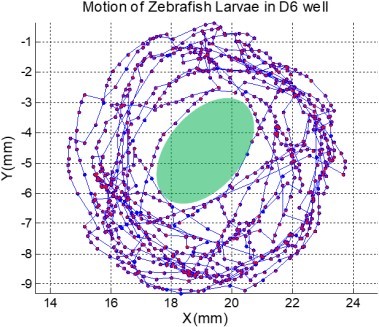
Below: Zebrafish physiology affected by stressors (light, thermal, centrifugation), and the effect of suborbital flight on gene expression.
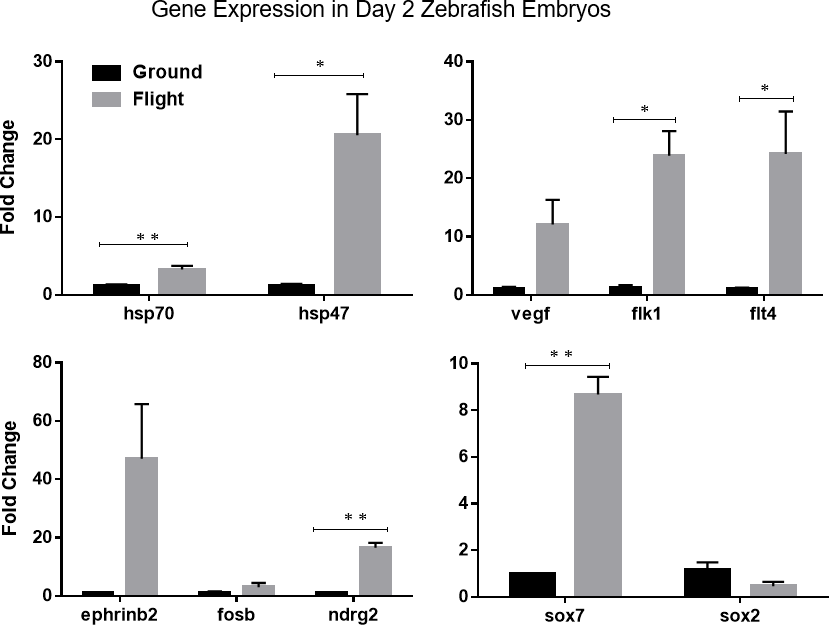
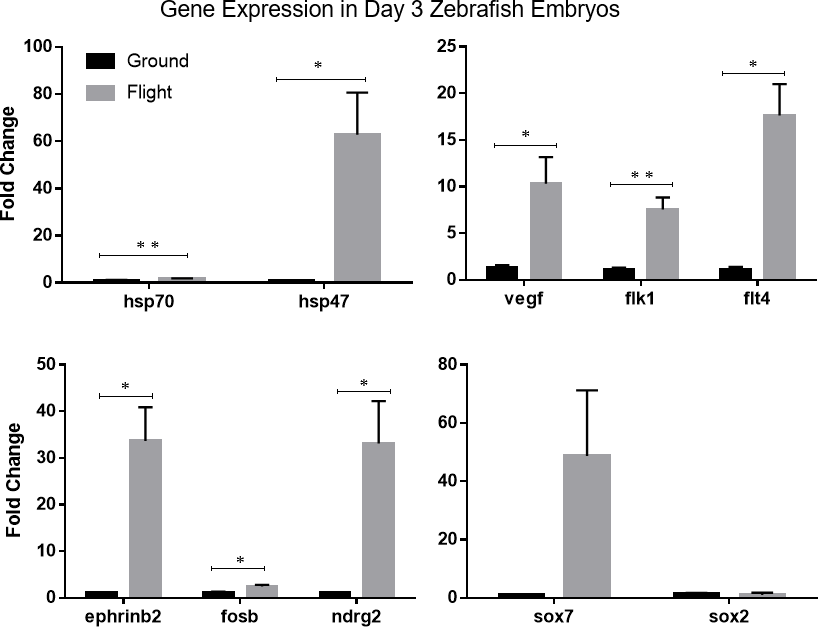
Below left: New Shepard’s Capsule. Below right: NanoLab science experiment with zebrafish embryos and spirulina.
Below left: Flight Zebrafish embryos. Below right: Confocal microscopy of zebrafish.
Below: Confocal microscopy of spirulina flight samples.
Categories: Faculty-Staff
-
Aviation/Aerospace Research: Suborbital Space Flight Simulator
PI Pedro LLanos
CO-I Erik Seedhouse
The Suborbital Space Flight Simulator (SSFS) replicates in-vehicle parameters of a suborbital launch vehicle. These suborbital missions can be monitored from the Mission Control Center (MCC). These flight parameters include the size, general layout, and typical system indicators for a suborbital spaceflight mission, as well as an approximate replication of the visuals that would be seen on a suborbital spaceflight mission. The SSFS can be configured to replicate the mission profile and layout of multiple suborbital launch vehicles. The SSFS records 56 flight data parameters that can be used for studies. The SSFS can potentially be used by multiple organizations, with multiple capabilities.
This research will help students and researchers to use SSFS-generated data to improve their understanding of the fundamentals of suborbital space flight, improve the confidence levels of this research tool for training purposes, and generate large datasets of suborbital missions that can be used for flight operational quality assurance (FOQA). By analyzing these simulated suborbital flights, it will be possible to learn a great deal about the different parameters of various suborbital trajectories and assess pilot performance.
It will also be possible to assess metrics aligned with the flight profile and to determine difficulties the pilot encountered when flying nominal and off-nominal profiles. Some of these difficulties are addressed herein and displayed in a graphical context to assist the reader’s visualization. This research capability enhances our understanding of some key factors, such as winds effects, trajectory, and vehicle parameters variations to streamline the space vehicle operations and enhance science in the upper mesosphere at about 85 km, where different types of science activities can be conducted, such as neutral dynamics, gravity waves, tides, oscillations, and noctilucent clouds imagery and tomography. Understanding these effects is crucial to refine current space operations and establish more robust procedures. These procedures will involve training new space operators to conduct and coordinate space operations in class E above FL600 airspace within the Air Traffic Organization (ATO). Space vehicles such as SpaceShipTwo can spend up to 6 minutes in class E airspace above FL600 after launch. Most of this time is dedicated to science data collection in microgravity and maximizing the science is a key priority. Typical suborbital trajectories cut through the noctilucent cloud layer in the mesosphere region from about 260,000 feet to 280,000 feet during the ascent and descent. This space activity falls within the D-layer of the ionosphere (50-90 km). In each of these segments, the space vehicle spends about 10 seconds in the region of interest, totaling about 20 seconds of total in-situ uninterrupted science in the mesosphere. The SSFS is an important tool to evaluate key functional data parameters that must be considered for suborbital spaceflight participants wearing pressurized suits for intravehicular activity (IVA) from Final Frontier Design’s (FFD) fully pressurized third-generation spacesuit as part of their training. Zephyr BioHarness, BioRadio instrumentation, and Hexoskin smart shirt can be used to collect biometric response data from the participants as they performed their duties inside the SSFS.The SSFS is also equipped with MCC with several consoles, such as Flight (Director), Surgeon, Weather, Integrated communications officer, and Air Traffic Control.
Images below: Mission Control Center and Suborbital Space Flight Simulator
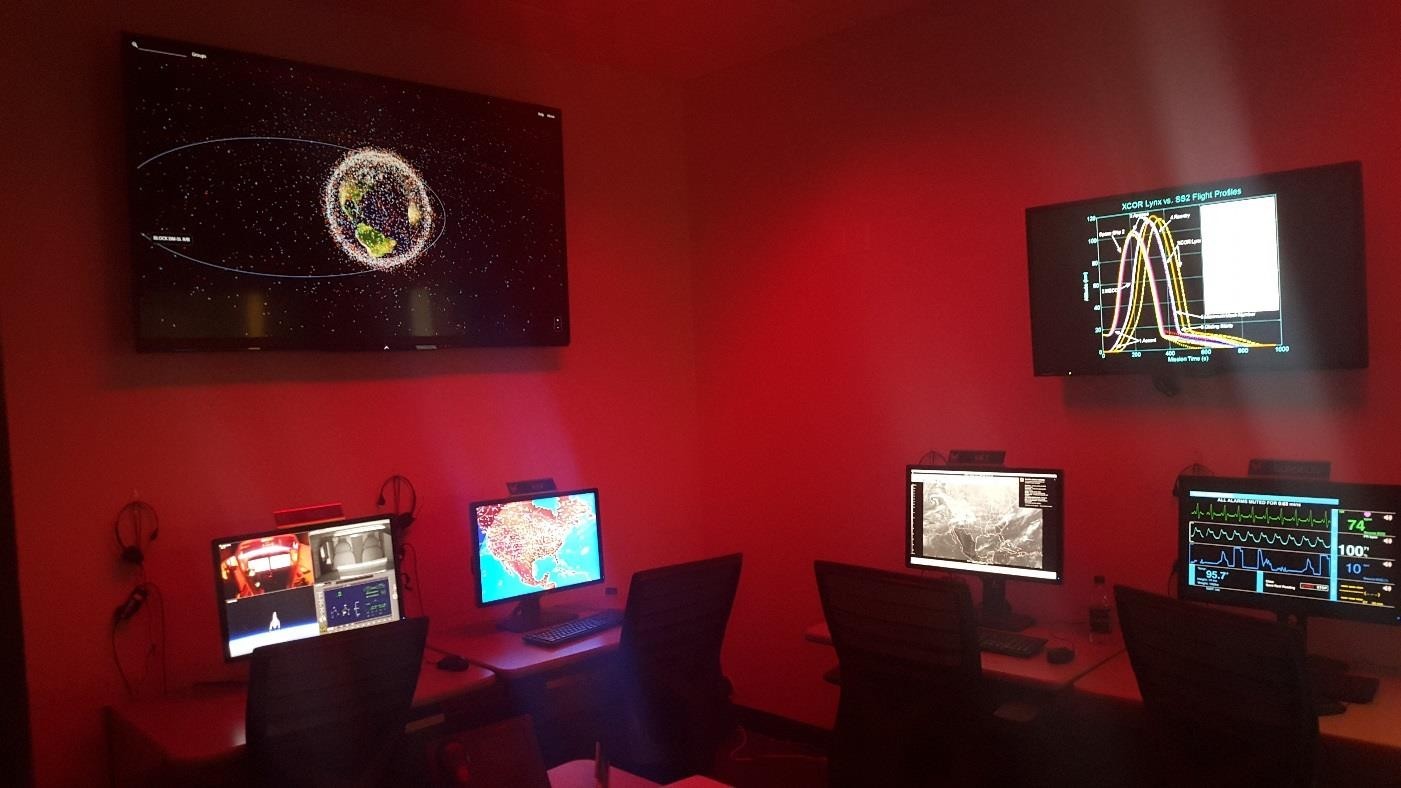
Images below: Examples of suborbital trajectories with several space vehicles. Some of these trajectories can be used to maximize science operations
Categories: Faculty-Staff
-
Blue Origin’s Suborbital Research: CRExIM
PI Pedro LLanos
CO-I Sathya Gangadharan
This research conducted with Co-Investigators Sathya Gangadharan (ERAU) and Kristina Andrijauskaite (MUSC/UTHSCSA), funded by ERAU’s Faculty Research Development Program, was ERAU's first suborbital payload aboard Blue Origin’s New Shepard launched December 12, 2017. The main aim of this research was to investigate the effect of microgravity on T-cells and to understand how this research could be used to develop T-cell-based therapeutics for cancer patients. A second goal was to monitor the environment that T-cells encountered during suborbital flight. The recorded data will be used to better understand the behavior and functionality of the T-cells when exposed to different stressors.
Suborbital space research is emerging as a popular platform to conduct scientific experiments. It has many advantages compared to research on the International Space Station (ISS), such as cost-effectiveness, rapid turnaround, and an opportunity to valid payloads before investing in more costly space laboratory environments. There have been many initiatives by NASA to accelerate this research, such as the release of the Space Biology Plan for 2016-2025, aimed to investigate the biological effects of long-term exposure to the space environment. Therefore, our scientific findings will build upon current research to expand the knowledge on the microgravity effect on T-cells and will also establish a baseline for us to compare future findings from subsequent suborbital flights aboard various research platforms.
This research project was a joint collaboration between the College of Aviation and the College of Engineering at ERAU and The University of Texas Health Science Center at San Antonio (UTHSCSA) and Medical University of South Carolina (MUSC) who worked on the preparation of the translational science research project aimed at investigating the effect of microgravity on the T-cells of a murine model. Cell Research Experiment In Microgravity (CRExIM) was launched aboard Blue Origin’s New Shepard suborbital vehicle on Tuesday, December 12, 2017, from the West Texas Launch Site in Van Horn, Texas. One of the aims of this science experiment was to assess the effects of microgravity on murine T-cells during suborbital flight. These cells were placed in a NanoLab with a data logger which sensed the acceleration, temperature, and relative humidity during pre-flight, flight, and post-flight operations. Some discrepancies in sensor measurement were noticed and these errors were attributed partly to the difference in sampling rates and partly to the different location of the sensors, which made it difficult to obtain highly accurate measurements of the accelerations and to correlate both sets of data. This research provides setbacks and lessons learned which made our team find new alternatives while meeting all milestones as mandated by NanoRacks and Blue Origin. This research highlights these alternatives which lead to the success of the mission and gives recommendations that will enable customers to alleviate some of these challenges in future flights.
Preliminary results suggest that suborbital space flight modulated the expression of certain subpopulations of T-cells, especially CD4+ and CD8+ cells. Thus, we have also observed the functional differences between the flown T-cells and the ground controls. Our scientific experiments and data analyses were conducted at Dr. Wargovich’s laboratory at UTHSCSA using the flow cytometry core facility. In addition, we have performed a complex cytokine expression analysis using the Invitrogen Mouse Custom ProcartaPlex 5-plex.
Below top: Our team with Blue Origin and NanoRacks teams. Below bottom: Our payload and data collected during the suborbital flight.
Categories: Faculty-Staff
-
Rocketry as Testing Platforms for Payloads
PI Pedro LLanos
CO-I Sathya Gangadharan
Design, assemble and launch small rockets as testing platforms to test small payloads which are flown aboard suborbital flight vehicles. We have successfully launched Level 1, Level 2 rockets, and we are in the process of finalizing the Level 3 rocket.
Practical experience for students in rockets and payloads is very valuable in the space industry, and it is something that would give them an advantage over other applicants. Students in Embry-Riddle Aeronautical University’s Payload and Integration class were given the opportunity to build Level 1 and Level 2 rockets and gain experience developing, testing, and integrating payloads into a rocket. These payloads were then flown to suborbital space aboard Blue Origin’s New Shepard.
Embry-Riddle Aeronautical University has launched several suborbital scientific payloads aboard Blue Origin’s New Shepard in 2017 and 2019. Students continue gaining hands-on experience in rocket design and construction, and payload integration, and testing of future and more mature payloads to be launched into space.
This research project funded by the College of Aviation Department of Applied Aviation Sciences and ERAU Ignite research grants, a Level 3 Rocket is being designed and developed at ERAU to serve as a scaled-down model research platform for launching and testing of payloads that will be later flown in commercial suborbital platforms such as Blue Origin’s New Shepard and PLD space Miura 1 rockets. Computer simulations were conducted to calculate the key parameters such as flight trajectory profiles, stability, and flight velocities for different rocket motors configurations. A preliminary design of the rocket was developed using Computer-Aided Design (CAD) software. The rocket will accommodate multiple payloads (Cubesats, NanoLabs, TubeSats) designed and developed in the Payload Applied, Technology and Operations (PATO) laboratory. The rocket is primarily constructed of carbon fiber composite as it has a high strength-to-weight ratio. Monte Carlo simulations are used to select a suitable motor for the rocket according to the flight requirements and landing restrictions.
Images below: Level 1 and Level 2 rockets
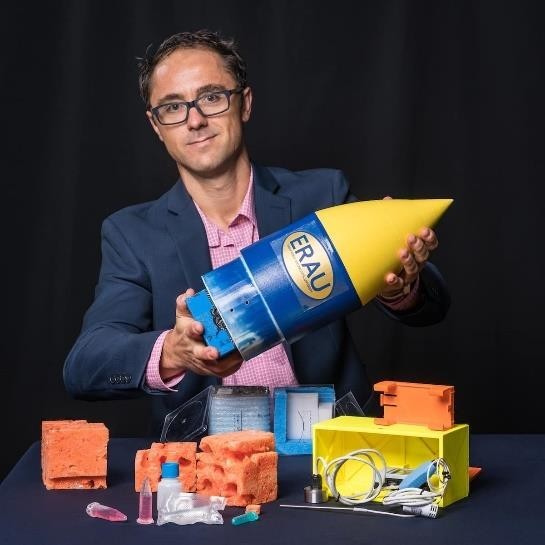
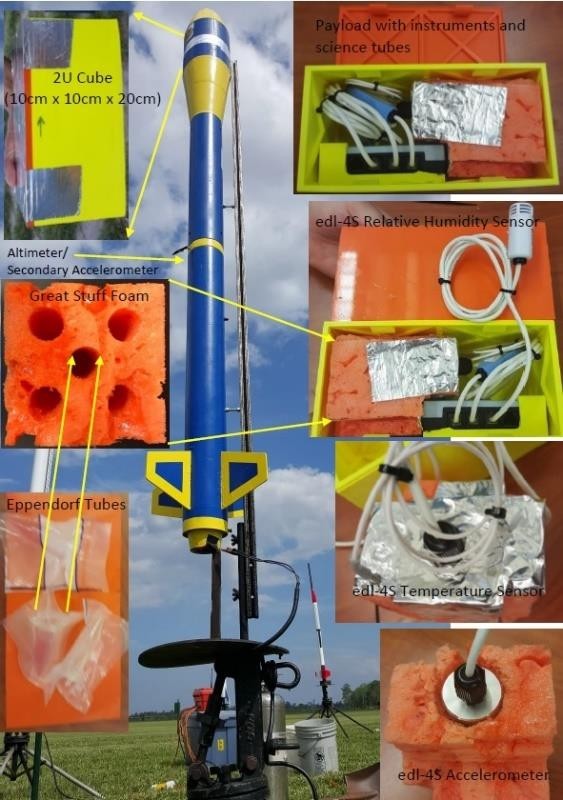

Images below: Construction of level 3 rocket. Payload bay housing several CubeSats, NanoLabs and TubeSats.
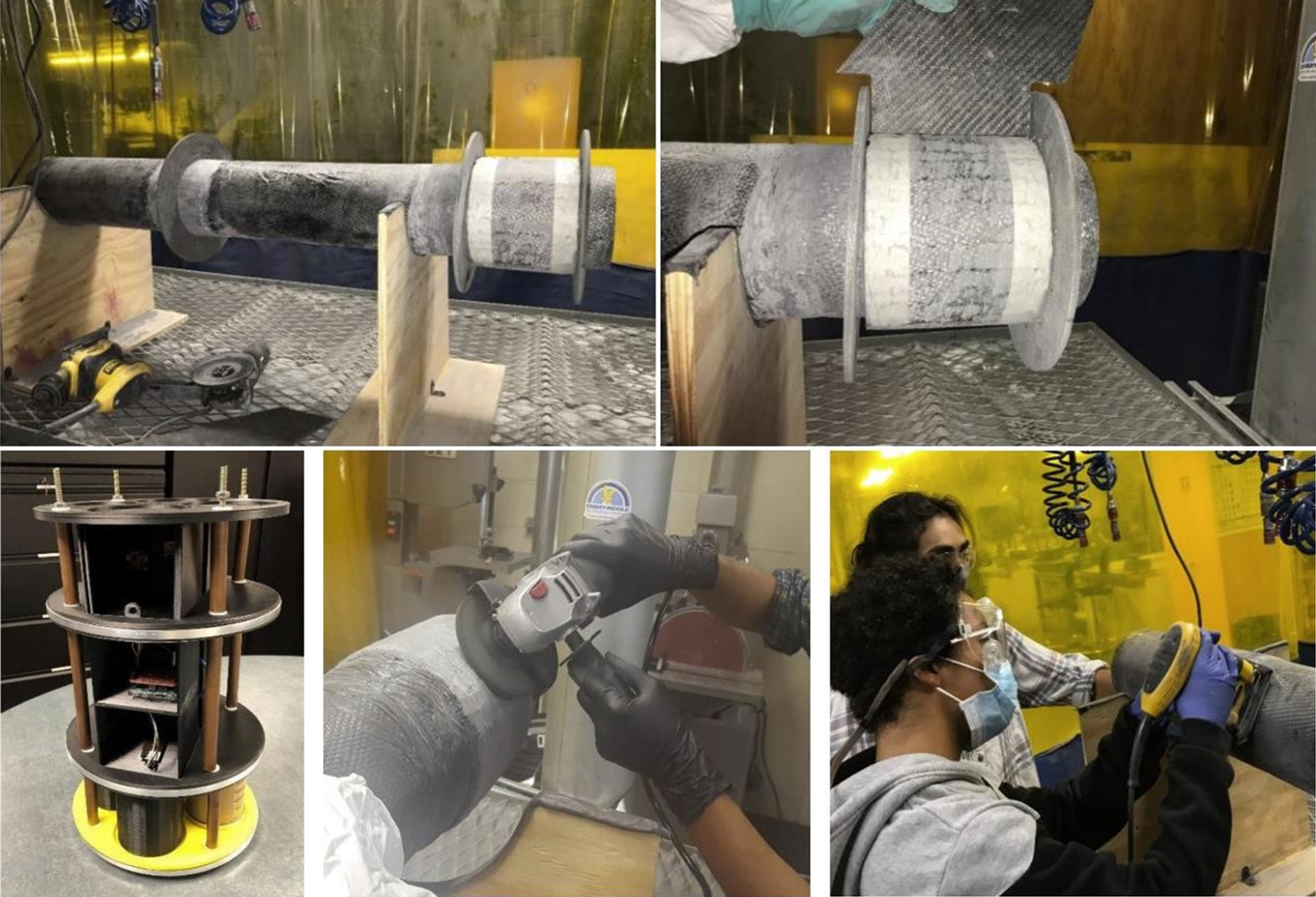
Categories: Faculty-Staff
-
NASA’s Embry-Riddle High-Altitude Science Experiment Rig (ERHASER)
PI Pedro LLanos
CO-I Sathya Gangadharan
The purpose of this study aboard the NASA’s Airborne Science Program WB-57 aircraft was to assess the effect of radiation on murine naïve and activated T lymphocytes (T cells) and to test the effectiveness of thermal, radiation and flight tracking technology in biological scientific payloads. Flight cells were kept under proper environmental conditions by using an active thermal system, whereas the levels of radiation were measured by NASA’s Timepix radiation sensor during ascent, cruise at 60,000 feet, and descent.
Exposure to space radiation may place astronauts at significant health risks. This is an under-investigated area of research and therefore more knowledge is needed to better plan long-term space missions. We cultured cells in specific cytokines known to increase their viability and exposed them to either flight or had them as ground controls. In addition, an Automatic Dependent Surveillance-Broadcast (ADS-B) device was utilized to track the state vector of the aircraft during flight. The aims of this pilot research study were:
Aim 1: The first aim was to study the position of the aircraft using the ADS-B device for subsonic or supersonic flights through triangulation from communication nodes along the Gulf of Mexico, which had never done before. We aimed to get insights into some challenges the Federal Administration Aviation (FAA) is facing with integrating the newly emerging era of suborbital space vehicles into the National Air Space.
Aim 2: The second objective was to test the effects of radiation using the Timepix, a sensor that had flown on NASA’s Exploration Flight Test (EFT)-1 On December 5, 2014, and that had never flown before aboard this aircraft to study the radiation levels at 60,000 ft.
Aim 3: Next, we wanted to assess the radiation levels on the immune cells, also called T cells. We used both naïve and activated murine T cells, which were supplemented with cytokines IL-2 and IL-12, as well as treated with the novel supercritical CO2 extract of neem tree Azadirachta indica (SCNE). Interleukin-2 (IL-2) is a potent T cell growth factor used for T cell expansion and treatment of several types of cancer [23]. IL-12 is involved in the differentiation of naive T cells into the T helper cells. It is also known as a T cell-stimulating factor, and a promising agent in cancer immunotherapy [24]. These two cytokines facilitate their effect by targeting the immune system. We sought to investigate whether exposure to radiation and other flight stressors would have any effect on these cells, especially at the 60,000 feet, where peak galactic cosmic rays (GCR) scattering of secondary particles occurs. Given the cytokines' ability to alter the cellular processes and the role of supercritical extract as the natural compound with pluripotent properties, we wanted to test whether supplementing cells with these additives would rescue the cells of radiation damage. We performed the phenotypic analysis of the cells and assessed their ability to release cytokines.
Aim 4: The fourth objective included the development of an Environment Control Life Support System (ECLSS) NanoLab, which could be used to host and sustain the cells at the desired temperature while other variables are being tested.
Below: Timeline of the airborne research experiment.
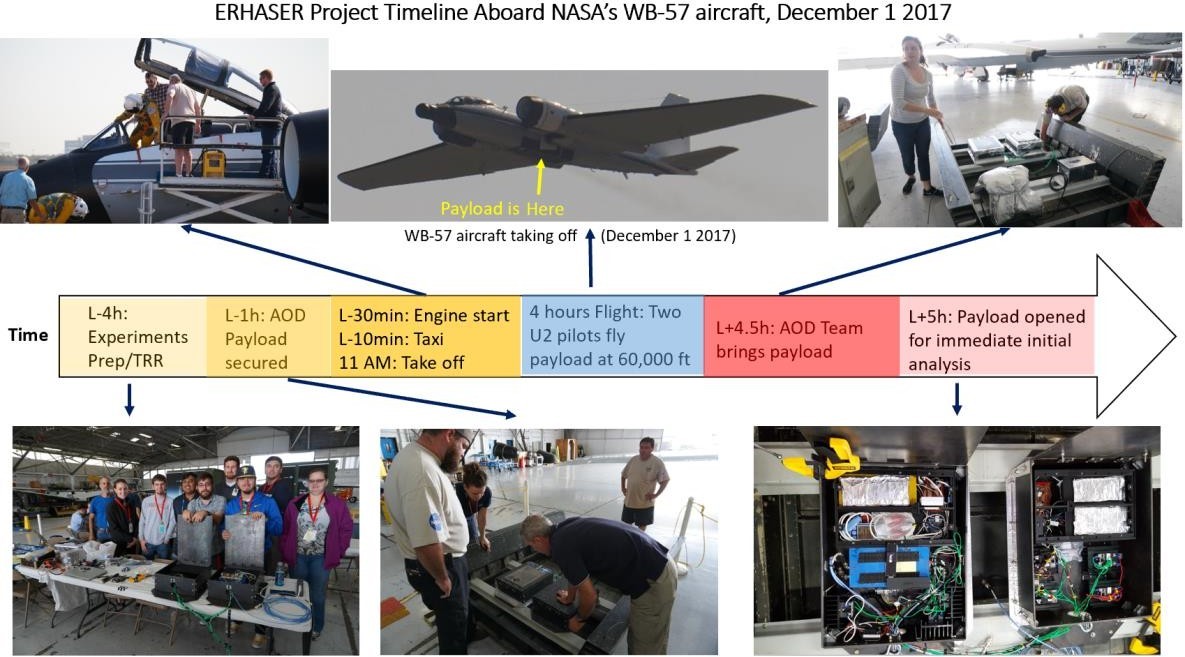
Below left: Temperature profile during flight. Below right: Total radiation dose during flight.
Below: Example of effects of flight on the expression of cytokines of T cells and Naïve cells.
Below: ERAU team picture at NASA’s Ellington Field, Houston, Texas, 2019.
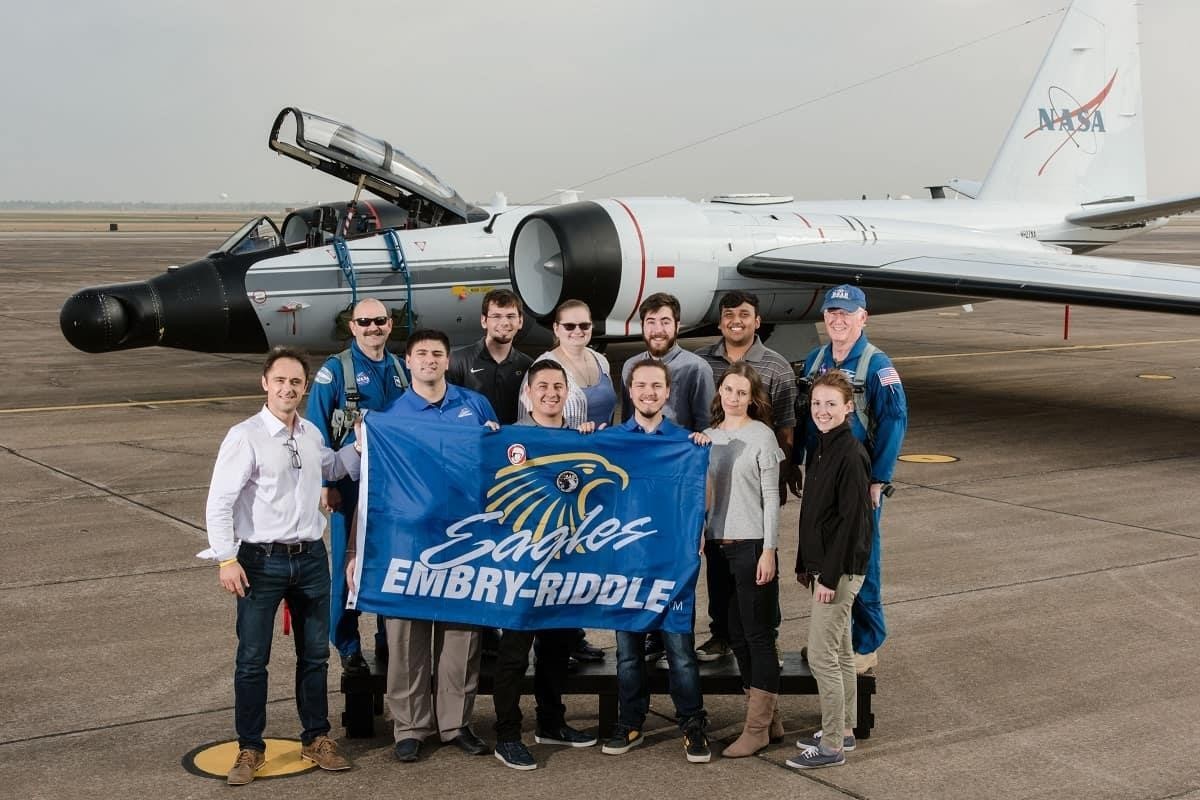
Categories: Faculty-Staff
-
Environmental Analysis of Convective Initiation Events in Central Florida using Integrated Mobile Observation
PI Shawn Milrad
PI Daniel Halperin
This research collaboration with the National Weather Service (NWS) Weather Forecast Office Tampa Bay aims to develop an ingredients-based methodology to help improve forecasts of first-strike cloud-to-ground lightning strikes in summer thunderstorms across Central Florida. Results will be used to construct a new forecast tool that will aid NWS forecasters in protecting the region’s life and property from these dangerous lightning events.
Lightning is a major hazard to life and property in Florida and annually leads the nation in lightning strikes and fatalities. The proposed research collaboration with the National Weather Service (NWS) Weather Forecast Office Tampa Bay aims to develop an ingredients-based methodology to help forecast first strike cloud-to-ground lightning strikes in warm-season thunderstorms across Central Florida. A comprehensive environmental analysis of these convective initiation events is being performed using numerous observational datasets, including mobile radar and surface observations from recent ERAU field courses and campaigns. The environmental analysis will examine first-strike events across the eight large-scale flow regimes previously identified by NWS Tampa Bay. A particular focus is placed on events that occurred during four weeks of ERAU field courses/campaigns in 2015 and 2018, allowing for the unique integration of mobile observations. Results are being used to construct a new forecast tool integrated with existing radar- and satellite-based lightning tools, to improve first-strike alert lead times. Also, the proposed project has established a fruitful collaborative research relationship between ERAU and NWS Tampa Bay while providing research experience and training for several ERAU undergraduate meteorology majors. These undergraduate students have completed much of the work on the project and have gotten to interact with NWS Tampa Bay personnel. It is expected that this project will also stimulate future more significant research collaborations between ERAU Meteorology and regional NWS forecast offices.Categories: Faculty-Staff
-
Transfer and Retention of Training in Real and Virtual Spaceflight Environments
PI Erik Seedhouse
This research compared how effectively suborbital tasks are learned in an actual NBE compared with a VR-rendered NBE. This study demonstrated the efficacy of NBE-type training as a means to improve the effectiveness of training suborbital SFPs.
Manned suborbital spaceflights are just around the corner. SpaceShipTwo, operated by Virgin Galactic and New Shepard, operated by Blue Origin, will most likely fly fare-paying passengers sometime in 2020. Each passenger will pay $250,000. And, with just four minutes (240 seconds) of actual microgravity time, that equates to almost $1000/second. For spaceflight participants (SFPs) a category which will include tourists and scientists, the cost of incorrectly performing even simple tasks will be extremely costly.
In spaceflight, even for highly trained astronauts, the tactile-kinesthetic and vestibular systems are affected by weightlessness. Of course, astronauts traveling to the International Space Station (ISS) have plenty of time to adapt, but SFPs will have no time at all – the time from rocket ignition to microgravity is less than 5 minutes. Compounding this lack of adaptation is the fact that suborbital SFPs will generally only have 3 days of training (compared with many years of training for an astronaut headed to the ISS). To overcome the aforementioned difficulties this study evaluated two spaceflight analogous training systems specific to suborbital spaceflight: one that will take place in an actual neutral buoyancy environment (NBE) and one that will take place in a virtual reality (VR) NBE.
To date, there have no studies that have evaluated the effectiveness of VR as a means of training suborbital SFPs. Nor have there been any studies that evaluate the utility of NBE-type training for suborbital SFPs. Not only did this study assess the effectiveness of each of these methods of training. It also developed a training tool for the commercial suborbital spaceflight industry. To that end, this study sought to achieve three objectives:
- Measure the effectiveness of neutral buoyancy dive training while wearing the EasyDive system as a means to train suborbital SFPs in a swimming pool
- Measure the effectiveness of neutral buoyancy dive training in an underwater-simulated VR environment as a means of improving maneuvering and performance of tasks in microgravity.
- Based on the results of objectives #1 and #2 a training program for SFPs will be devised.
Categories: Faculty-Staff
-
Small UAS (sUAS) Mid-Air Collision (MAC) Likelihood
PI Ryan Wallace
CO-I Dothang Truong
CO-I Scott Winter
CO-I David Cross
This research focuses on sUAS MAC likelihood analysis with general aviation (GA) and commercial aircraft. Because severity research varies based on where a collision occurred on a manned aircraft, this likelihood research will not only look at the probability of a MAC, but also the likelihood of colliding with different parts of a manned aircraft.
Complete Mid-Air Collision (MAC) risk assessments require estimates of both collision severity and collision likelihood. This research focuses on sUAS MAC likelihood analysis with General Aviation (GA) and commercial aircraft. Because severity research varies based on where a collision occurred on a manned aircraft, this likelihood research will not only look at the probability of MAC but also the likelihood of colliding with different parts of a manned aircraft.
Categories: Faculty-Staff
-
Usability of Urban Air Mobility: Quantitative and Qualitative Assessments of Usage in Emergency Situations
PI Scott Winter
CO-I Stephen Rice
CO-I Sean Crouse
The purpose of these studies is to determine the usability of urban air mobility (UAM) vehicles in the emergency response to natural disasters and the ideal locations for their take-off and landing sites to occur, consistent with the Center's Theme 2. UAM involves aerial vehicles, mostly operated autonomously, which can complete short flights around urban areas, although their applications are expanding to rural operations as well. While initially designed to support advanced transportation mobility, these vehicles could offer numerous advantages in the emergency response to natural disasters. Through a series of four studies with over 2,000 total participants, quantitative and qualitative methods will be used to identify UAM vehicles' usability in response to natural disasters. The studies will examine the types of natural disasters and types of missions where UAM could be considered usable, along with the creation of a valid scale to determine vertiport usability. Interviews will also be conducted to provide qualitative insights to complement the quantitative findings.
In this proposed series of four studies, our overall purpose will be to determine the usability of urban air mobility in the emergency response to natural disasters. As the concepts of urban air mobility move closer to reality, these mostly autonomous aerial vehicles may provide valuable contributions to our response after natural disasters. However, little prior research has examined the types of natural disasters, types of missions, or locations where UAM could be deployed in the emergency response. The first objective of this research will be to assess the usability of UAM based on the type of natural disaster and type of mission. Following this, the research will develop a valid scale to measure possible locations where UAM operations could be conducted following a natural disaster, such as city parks, building rooftops, or existing helipads. The final objective of this study will be to gather qualitative data through interviews to complement the quantitative findings and offer more significant insights and explanations as to the usability of UAM in response to natural disasters.Categories: Faculty-Staff
-
NASA/ZeroG Microgravity Research
CO-I Pedro LLanos
CO-I Sathya Gangadharan
Embry-Riddle Aeronautical University and Carthage College proposed a technology demonstration that has several advantages over passive slosh control. Relative to slosh baffles, the proposed MAPMD technology has a lower total mass, a much higher degree of surface wave suppression, and less volumetric intrusion into the tank. The MAPMD concept also is optimized for cylindrical tanks (unlike elastomeric diaphragms, which work only in spherical pressure vessels), and currently requires no structural design changes to existing cylindrical propellant tanks.
The objective of the current research project under PI Kevin Crosby (Carthage College and University of Texas Health Science Center in San Antonio) is to demonstrate the effectiveness of a low-gravity active-damping diaphragm in reducing the gauging uncertainty of the Modal Propellant Gauging (MPG) technology during propellant slosh. The active damping system relies on a cross-woven mesh of magnetic alloy film embedded in a polymer matrix and formed into a thin circular membrane that floats freely (in 1-g) on the surface of the propellant. The alloy has a large magnetic permeability and demonstrates strong magnetostriction (expansion) under a static applied magnetic field. When formed into a mesh, the alloy is a “smart material” that experiences dramatic changes in structural properties under an applied magnetic field, expanding and stiffening from a pliable mesh to a more rigid structure. A secondary effect of the interaction of the alloy with an applied magnetic field is that the mesh can be induced to accelerate along magnetic field gradients, generating forces on the liquid that can further damp slosh waves. It is the enhanced rigidity and the restorative damping force of the membrane that we exploit in this technology to suppress surface waves and to localize propellant during slosh. The active damping technology used in this technology demonstration has been under development for several years at Embry Riddle Aeronautical University. We refer to the mesh alloy embedded in the polymer matrix as a “Magnetoactive Propellant Management Device” (MAPMD). The MAPMD was developed by one of the authors of this proposal who, in partnership with Embry Riddle Aeronautical University, holds the patent for its application to slosh control (Sivasubramanian, et al., 2016). MAPMD has been demonstrated to suppress slosh in 1-g laboratory testing at the ERAU slosh facility with an effective reduction in slosh amplitudes of up to 50% for the low-mode rocking slosh commonly seen in low-gravity propellant slosh (Santhanam, et al., 2015).
Internal tank diaphragms have long been used in propellant management to control slosh. The diaphragm concept has evolved from elastomers with fixed boundaries on the inside walls of the tank to floating “micro-baffles” that move with the propellant to damp surface oscillations (Paul, 2016). While floating micro-baffles offer reliable slosh suppression in normal (1-g) gravity, the absence of a buoyant force in zero-g precludes their use in most space applications.
We proposed to test a hybrid of the existing MAPMD diaphragm in which an external magnetic field is used to position the free diaphragm near the top surface of the liquid in low gravity (where buoyant forces are not active). By adjusting the gradient of the magnetic field, the position of the diaphragm can be manipulated with high resolution, while the strength of the magnetic field determines the restorative forces applied to the sloshing liquid. The “Field Gradient Control” method of positioning a free-floating diaphragm is a new approach to propellant slosh mitigation that is both minimally invasive to the propellant tank (requiring only the free-float diaphragm inside the tank) and is scalable to large tank systems. The proposed test had three key objectives:
Objective 1: Demonstrate the ability to position the MAPMD diaphragm at the free surface of the liquid using field gradient positioning
Objective 2: Measure the reduction in slosh amplitude of low-gravity propellant simulant slosh when the MAPMD is activated (relative to passive diaphragm slosh suppression), and
Objective 3: Correlate the reduction in slosh amplitude with enhanced low-gravity gauging resolution of the MPG technology. The reduction in slosh amplitude will be measured relative to a free-floating but unactuated MAPMD.
Image below: Parabolic flight November 2019
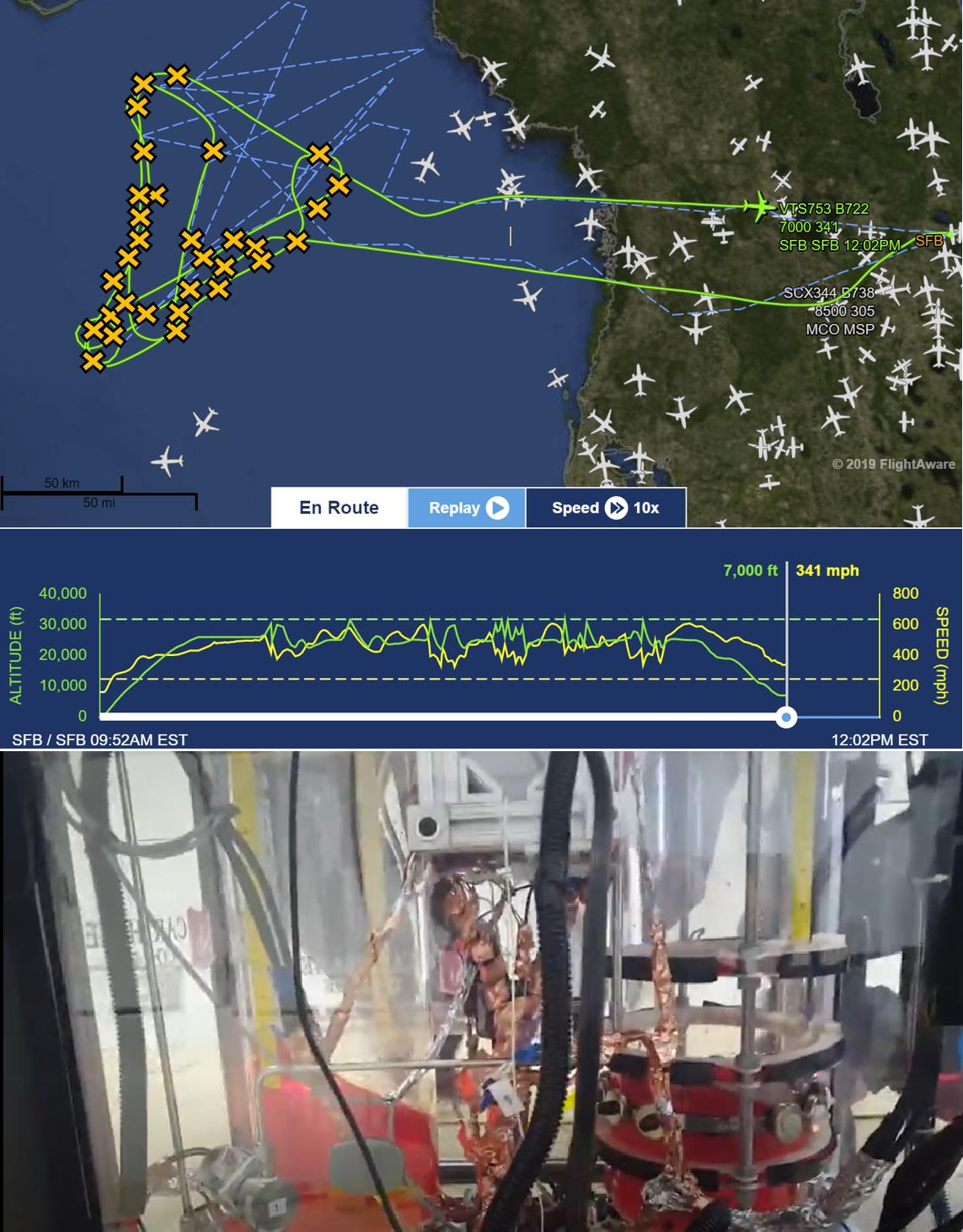
Image below: Parabolic flight November 2020
Image below: Accompanied with Carthage College and ERAU students
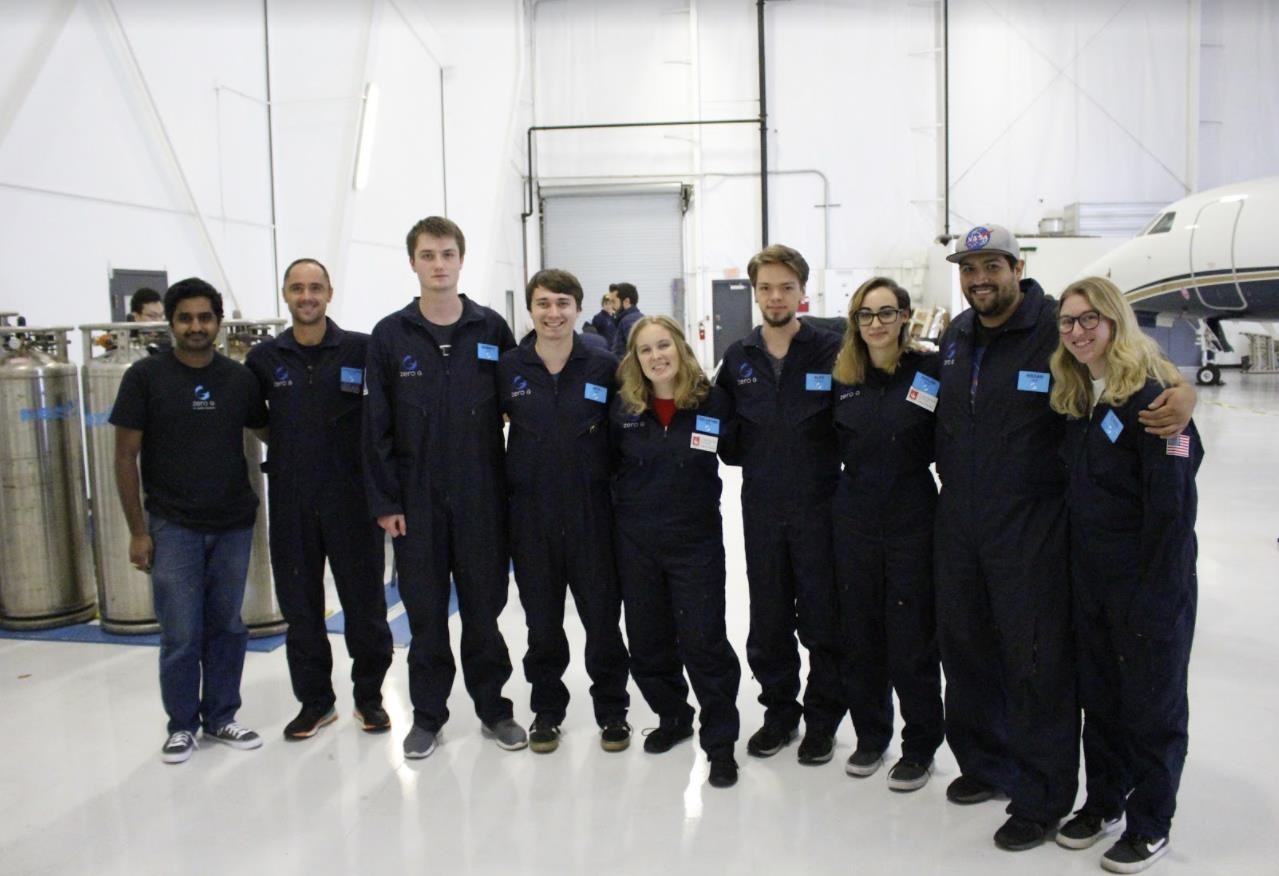
Categories: Faculty-Staff
11-20 of 21 results

